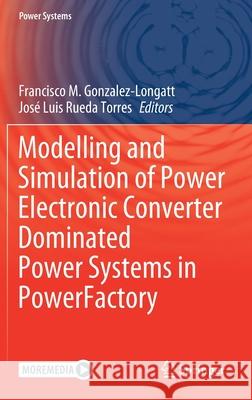Modelling and Simulation of Power Electronic Converter Dominated Power Systems in Powerfactory » książka



Modelling and Simulation of Power Electronic Converter Dominated Power Systems in Powerfactory
ISBN-13: 9783030541231 / Angielski / Twarda / 2020 / 377 str.
Modelling and Simulation of Power Electronic Converter Dominated Power Systems in Powerfactory
ISBN-13: 9783030541231 / Angielski / Twarda / 2020 / 377 str.
(netto: 576,41 VAT: 5%)
Najniższa cena z 30 dni: 578,30
ok. 22 dni roboczych.
Darmowa dostawa!
Online material available
Power Electronic modelling and simulations using DIgSILENT PowerFactory.- Integration of Large Scale Photovoltaic Power Plants into Power Networks to Maintain System Stability.- Dynamic Modelling and Simulation of Power Electronic Converter in DIg-SILENT Simulation Language (DSL): Islanding Operation of Microgrid System with Multi Energy Sources.- Dynamic Modelling and Co-Simulation between Matlab-Simulink and DIgSILENT PowerFactory of Electric Railway Traction Systems.- Transient Stability Assessment of Power System Incorporating DFIM-Based Pumped Storage Hydropower and Wind Farm.- Implementation of a Generic Type 3 Wind Turbine Model in DIgSILENT PowerFactory.- Battery Energy Storage System Modelling in DIgSILENT PowerFactory.- A benchmark test system for the power system stability assess-ment considering very high penetration of converter based generation units including grid forming converters.- System protection schemes as a way to prevent bottlenecks of the power system considering the Integration of Ofshore and onshore wind turbines and HVDC link.- Implementation and performance comparison of derivative and virtual synchronous power methods for enhancement of system frequency stability.- Modelling and simulation of wind turbines with grid forming direct voltage control and black-start capability.- Generic Modelling of PEM Technologies for Power System Stability Studies Based on PowerFactory.- PST-17 Benchmark Power System DSL-based model with 90% Power Electronic Interfaced Generation with Black-Start and Grid Restoration capabilities in DIgSILENT PowerFactory.- Applications of PowerFactory for the study of basic notions of power system dynamics in graduate courses.
Prof Francisco M. Gonzalez-Longatt received his Ph.D. from Universidad Central de Venezuela in 2008, and his master’s degree from Universidad Bicentenaria de Aragua in 1999. He has been working in academia since 1992, and is currently a Professor of Electrical Power Systems at the University of South-Eastern Norway. He is a member of various professional organisations, and is a Fellow of the Higher Education Academy and a senior member of the IEEE. He has been involved in several industrial research projects and consultancy worldwide. Further, he is the author or editor of numerous books (Spanish and English) and an associate editor of several leading journals.
Prof José Luis Rueda Torres received his Electrical Engineer Diploma with cum laude honours from Escuela Politécnica Nacional in 2004. In 2009, he received his Ph.D. degree in Electrical Engineering from the National University of San Juan, where he had studied with a scholarship from DAAD. In 2014, became an Assistant Professor of Intelligent Electrical Power Grids at the Department of Electrical Sustainable Energy, Technical University Delft, and was promoted to Associate Professor in 2018. He has taken part in various professional activities including chairing or vice-chairing multiple committees and working groups, being on conference boards, and working as an associate editor for the ‘Swarm and Evolutionary Computation Journal’. His current research interests include power system reliability and stability, modelling for steady-state and dynamic stability studies (off-line and real-time digital simulation), optimal control design and multi-energy systems.
This book provides an overview of power electronic converters for numerical simulations based on DIgSILENT PowerFactory. It covers the working principles, key assumptions and implementation of models of different types of these power systems.
The book is divided into three main parts: the first discusses high-voltage direct currents, while the
second part examines distribution systems and micro-grids. Lastly, the third addresses the equipment and technologies used in modelling and simulation. Each chapter includes practical examples and exercises, and the accompanying software illustrates essential models, principles and performance using DIgSILENT PowerFactory.
Exploring various current topics in the field of modelling power systems, this book will appeal to a variety of readers, ranging from students to practitioners.
1997-2025 DolnySlask.com Agencja Internetowa
KrainaKsiazek.PL - Księgarnia Internetowa









